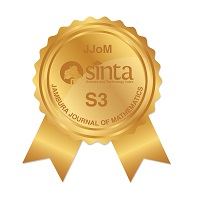Penerapan Metode I-CHAID Menggunakan SMOTE pada Data Tidak Seimbang untuk Klasifikasi Durasi Studi Mahasiswa
Abstract
Keywords
Full Text:
PDFReferences
F. Nofratama, H. Hasrul, H. Muchtar, and S. F. Dewi, "Kendala Keterlambatan Penyelesaian Studi Mahasiswa PPKn FIS Universitas Negeri Padang" J. Educ. Cult. Polit., vol. 2, no. 2, pp. 185-191, Nov. 2022, doi: 10.24036/jecco.v2i2.106.
A. Adawiyah, S. Sulfasyah, and J. Arifin, "Implikasi Pendidikan Nonformal Pada Remaja" Equilib. J. Pendidik. Sosiol., vol. 4, no. 2, pp. 1-8, Feb. 2017, doi: 10.26618/equilibrium.v4i2.506.
M. Annur, J. A. Dahlan, and F. Agustina, "Penerapan Metode Multivariate Adaptive Regression Spline (MARS) untuk Menentukan Faktor yang Mempengaruhi Masa Studi Mahasiswa FPMIPA UPI" J. EurekaMatika, vol. 3, no. 1, pp. 135-155, 2015, [Online]. Available: https://dspace.uii.ac.id/123456789/27720
I. G. A. M. Srinadi and D. P. E. Nilakusumawati, "Analisis Waktu Kelulusan Masiswa FMIPA Universitas Udayana dan Faktor-faktor yang Memengaruhinya" E-Jurnal Mat., vol. 9, no. 3, p. 205, Sep. 2020, doi: 10.24843/MTK.2020.v09.i03.p300.
N. D. Larasati and W. S. Jatiningrum, "Analisis Faktor pada Keterlambatan Studi Mahasiswa Teknik Industri Universitas Ahmad Dahlan" Manaj. Pendidik., vol. 16, no. 2, pp. 83-96, Dec. 2021, doi: 10.23917/jmp.v16i2.12134.
S. Sulasteri, F. Nur, and A. Kusumayanti, "Faktor-faktor penyebab keterlambatan mahasiswa uin alauddin makassar menyelesaikan skripsi" J. Idaarah, vol. III, no. 1, pp. 96-113, 2019, doi: https://doi.org/10.24252/idaarah.v3i1.9389.
S. Telaumbanua, S. A. Abimannyu, and G. Y. Abdullah, "Literatur Review : Pendekatan Naïve Bayes Untuk Klasifikasi Penyakit Tanaman Kentang" BIIKMA Bul. Ilm. Ilmu Komput. dan Multimed., vol. 2, no. 3, pp. 420-428, 2024, [Online]. Available: https://jurnalmahasiswa.com/index.php/biikma/article/view/1603
E. Novianto, S. Suhirman, and D. Prasetyo, "Perbandingan metode klasifikasi random forest dan support vector machine dalam memprediksi capaian studi mahasiswa" JIPI (Jurnal Ilm. Penelit. dan Pembelajaran Inform., vol. 9, no. 4, pp. 1821-1833, 2024, doi: https://doi.org/10.29100/jipi.v9i4.5423.
I. K. Hasan, R. Resmawan, and J. Ibrahim, "Perbandingan K-Nearest Neighbor dan Random Forest dengan Seleksi Fitur Information Gain untuk Klasifikasi Lama Studi Mahasiswa" Indones. J. Appl. Stat., vol. 5, no. 1, pp. 58-66, 2022, doi: 10.13057/ijas.v5i1.58056.
Z. Bula, R. Resmawan, L. O. Nashar, and S. K. Nasib, "Implementasi Improved Chi-Square Automatic Interaction Detection Pada Klasifikasu Faktor-faktor yang Mempengaruhi Literasi Informasi Generasi Muda" J. Stat. dan Apl., vol. 6, no. 2, pp. 214-222, Dec. 2022, doi: 10.21009/JSA.06207.
P. D. Yuliasari, R. Goejantoro, and F. D. T. Amijaya, "Klasifikasi Rumah Tangga Miskin Di Kecamatan Kaubun Tahun 2020 Dengan Menggunakan Metode Improved Chi-Square Automatic Interaction Detection" EKSPONENSIAL, vol. 12, no. 1, p. 83, Jun. 2021, doi: 10.30872/eksponensial.v12i1.765.
R. A. Barro, I. D. Sulvianti, and F. M. Afendi, "Penerapan Synthetic Minority Oversampling Technique (SMOTE) Terhadap Data Tidak Seimbang Pada Pembuatan Model Komposisi Jamu" Xplore J. Stat., vol. 1, no. 1, pp. 1-6, 2013, doi: 10.29244/xplore.v1i1.12424.
E. Erlin, Y. Desnelita, N. Nasution, L. Suryati, and F. Zoromi, "Dampak SMOTE terhadap Kinerja Random Forest Classifier berdasarkan Data Tidak seimbang" MATRIK J. Manajemen, Tek. Inform. dan Rekayasa Komput., vol. 21, no. 3, pp. 677-690, Jul. 2022, doi: 10.30812/matrik.v21i3.1726.
V. M. Santi, L. Nafisah, and Q. Meidianingsih, "Penerapan Metode SMOTE CHAID dalam Klasifikasi Tuberkulosis Relapse" J. Stat. dan Apl., vol. 6, no. 1, pp. 26-36, Jun. 2022, doi: 10.21009/JSA.06103.
I. S. Hidayati and I. M. Arcana, "Penerapan CHAID Dengan Pendekatan SMOTE Pada Kematian Balita di Kawasan Timur Indonesia Tahun 2017" Semin. Nas. Off. Stat., vol. 2019, no. 1, pp. 357-367, May 2020, doi: 10.34123/semnasoffstat.v2019i1.97.
I. C. Negara and A. Prabowo, "Penggunaan Uji Chi-Square untuk Mengetahui Pengaruh Tingkat Pendidikan dan Umur terhadap Pengetahuan Penasun Mengenai HIV-AIDS di Provinsi DKI Jakarta" Pros. Semin. Nas. Mat. dan Ter. 2018, vol. 1, no. 1, pp. 1-8, 2018.
C. P. Balasubramaniam and D. R. Gunasundari, "Supply Chain Enhancement Using Improved Chaid Algorithm for Classifying the Customer Groups" Int. J. Comput. Appl. Technol. Res., vol. 6, no. 8, pp. 378-383, Aug. 2017, doi: https://doi.org/10.7753/IJCATR0608.1006.
Y. Salsabila, A. Fatah, and J. Jaenudin, "Hubungan antara Literasi Numerasi terhadap Kemampuan Berpikir Kritis dan Kreatif Siswa SMP di Kecamatan Curug" Equal. J. Ilm. Pendidik. Mat., vol. 6, no. 1, pp. 42-54, Jun. 2023, doi: 10.46918/equals.v6i1.1789.
C. Damayanti, D. Kusnandar, and Yudhi, "Perbandingan Hasil Pembentukan Pohon Klasifikasi Metode CHAID dan Improved CHAID" Bul. Ilm. Mat, Stat, dan Ter., vol. 07, no. 4, pp. 10-27, 2018, doi: https://doi.org/10.26418/bbimst.v7i4.28655.
G. Zeng, "On the confusion matrix in credit scoring and its analytical properties" Commun. Stat. - Theory Methods, vol. 49, no. 9, pp. 2080-2093, May 2020, doi: 10.1080/03610926.2019.1568485.
DOI: https://doi.org/10.37905/jjom.v7i1.27978
Copyright (c) 2025 Umar D. Akor, Muhammad Rezky Fiesta Payu, La Ode Nashar

This work is licensed under a Creative Commons Attribution-NonCommercial 4.0 International License.
Jambura Journal of Mathematics has been indexed by
Jambura Journal of Mathematics (e-ISSN: 2656-1344) by Department of Mathematics Universitas Negeri Gorontalo is licensed under a Creative Commons Attribution-NonCommercial 4.0 International License. Powered by Public Knowledge Project OJS.
Editorial Office
Department of Mathematics, Faculty of Mathematics and Natural Science, Universitas Negeri Gorontalo
Jl. Prof. Dr. Ing. B. J. Habibie, Moutong, Tilongkabila, Kabupaten Bone Bolango, Gorontalo, Indonesia
Email: info.jjom@ung.ac.id.



















